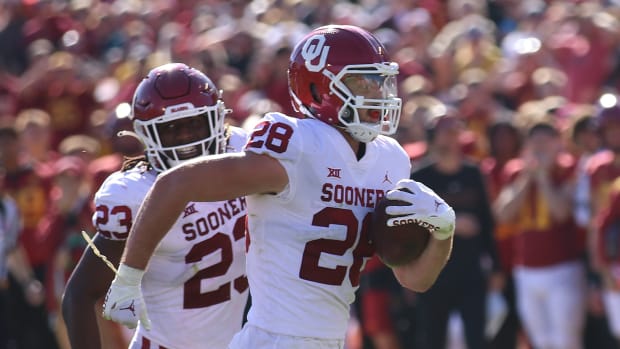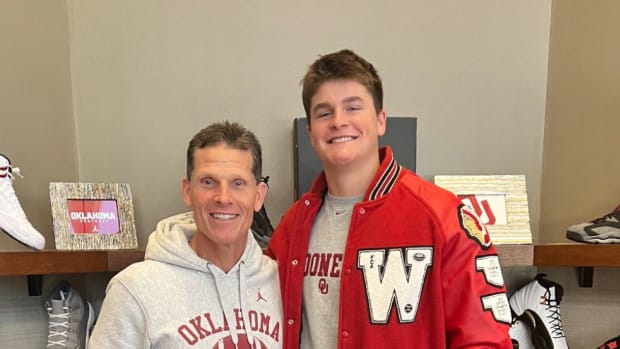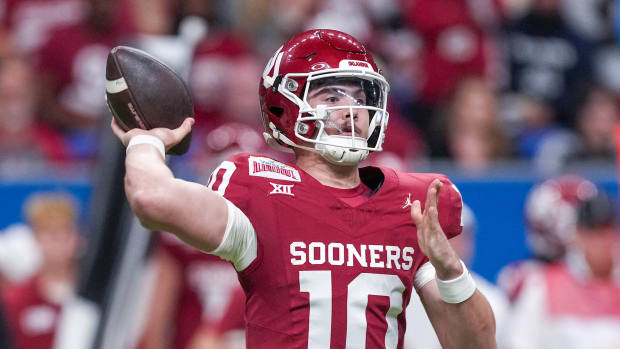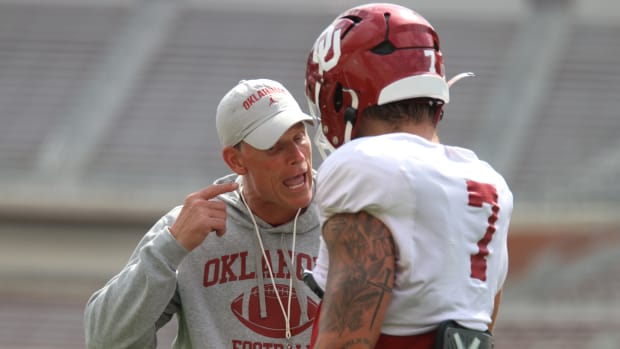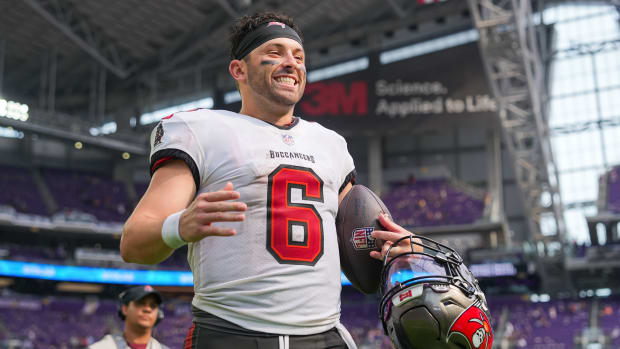COLUMN: Being Out of Touch Instead of Proactive Is What Cost the Big 12 ... Again
Watching the Texas Legislature’s takedown of University of Texas president Jay Hartzell and Big 12 Conference commissioner Bob Bowlsby on Monday was entertaining, if not illuminating.
Now, if someone could get some similarly uncomfortable answers out of Oklahoma president Joe Harroz, we’d have a more complete picture.
Alas, Harroz and OU athletic director Joe Castiglione didn’t take questions from the media during the special meeting of the OU Board of Regents last Friday, at which they announced the school’s plans to leave the Big 12 Conference for membership in the Southeastern Conference (circa 2025 or sooner). They merely read from lengthy statements.
We learned a few things, but only what they wanted us to learn.
The Texas state senate committee held a quorum on the Future of College Sports in Texas “to study the athletic and economic impact to Texas schools and communities by the University of Texas leaving the Big 12“ and got a little more out of Hartzell, Bowlsby and others in the Big 12, and it was powerfully revealing.
WATCH A REPLAY OF THE HEARING HERE
For instance, Bowlsby once again displayed a startling lack of awareness as Hartzell offered a few details about the meeting last week between he and Harroz and the Big 12’s executive committee consisting of Bowlsby, Baylor president Linda Livingstone and Texas Tech president Lawrence Schovanec.
As was previously reported, Hartzell said he and Harroz went into the meeting to listen to what the Big 12 trio had to say (and, presumably, what they had to offer), but the committee apparently went in with the same mindset.
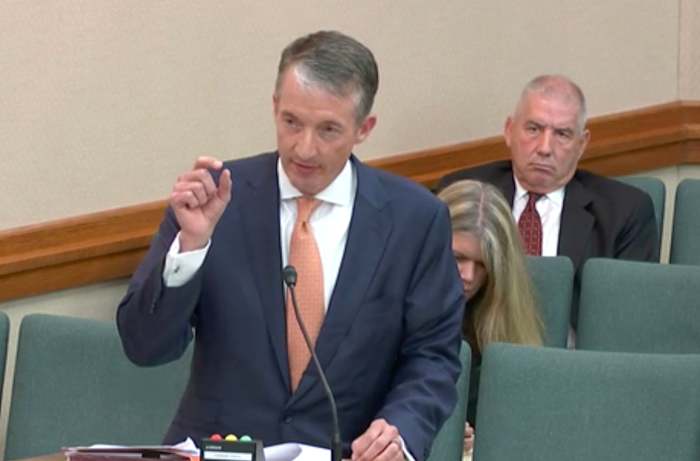
Texas president Jay Hartzell, watched closely this time by Big 12 Commissioner Bob Bowlsby
Screenshot: Texas Senate
“I think there was a little bit of a mismatch in the conversation where they wanted to hear a list of demands from us and we wanted to hear what they were thinking,” Hartzell said. “Neither side came into that conversation prepared to deliver what the other side was looking for.
“Ultimately, it didn’t change our course.”
That sounds like an awkward meeting.
Bowlsby said he was visiting the University of Kansas on July 21 when the Houston Chronicle reported that OU and Texas had reached out to the the SEC about joining that league.
Predictably, Bowlsby said he was “completely surprised” when his aircraft touched down in Dallas.
“I was not aware of anything prior to that day,” Bowlsby said.
At which, it should be surmised, Castiglione might or might not have been “bitterly disappointed.”
That Bowlsby couldn’t see this coming, couldn’t connect the dots since last summer and throughout a tumultuous spring, is not much of a surprise.
Realignment, Bowlsby said on July 14, is “not one of the things that keeps me up at night.”
It should have been.
Hartzell said Monday a conversation he had with Harroz last year about the possibility of changing conferences (“I don’t recall when it came up,” he said) got the ball rolling. Hartzell said he and Harroz discussed the idea of leaving the Big 12, and then said his first contact with the SEC happened last spring on a Zoom call with SEC commissioner Greg Sankey.
“We heard it was somewhat feasible,” Hartzell said. “After that, there were follow-up conversations trying to decide if we wanted to pursue this course of action or not, and then ultimately arrive at a decision that we did.”
As Harroz and Castiglione laid out last week, securing their university’s long-term strength and security was foremost. Hartzell echoed that sentiment Monday.
“We feel like the SEC has more security, more stability to be in a better spot in 2025 than the Big 12 does,” Hartzell said.
The sweeping and ongoing changes throughout collegiate athletics — detailed in-depth on Friday by Harroz and Castiglione and reiterated Monday by Hartzell — forced leadership at both schools to ask if the Big 12 was their best path forward or if there was another conference that provided a better future.
“I did think through, ‘Can the Big 12 get to that SEC-like future,’” Hartzell said. “And in my estimation, it was a low-probability event.”
Among reasons Hartzell cited for leaving was the Big 12’s uncertain future with its television partners. TV networks declined the league’s invitation this spring to initiate renegotiations — all while the SEC and the ACC were announcing record revenue distributions and new TV alliances.
“Uncertainty over what the eventual media rights deal the Big 12 would garner is uncertainty that I thought was real and a serious source of financial risk,” Hartzell said.
Hartzell also said Texas did nothing to break its contract with the Big 12 and emphasized that the school did not have any conversations with ESPN about changing leagues.
“Categorically, absolutely, no,” Hartzell said.
That no doubt either surprised or affronted Bowlsby, who said last week he has proof that ESPN acted in bad faith in actively trying to destabilize the Big 12 by incentivizing other conferences to poach its remaining members. Bowlsby even went so far as to write a cease-and-desist letter to the network. Bowlsby on Monday acknowledged the Big 12’s dissolution likely would mean no buyouts, penalties or grant-of-rights fees would need to be paid by OU and Texas for leaving prior to 2025.
However, Bowlsby added Monday that after ESPN president Magnus Burke issued a statement saying Bowlsby’s claims have “no merit,” there would be no further hostilities between his league and its primary media partner.
“I have spent a number of conversations with representatives of ESPN,” Bowlsby said, “and we have agreed to not escalate this publicly. It’s in neither party’s best interest to do so.”
He’s right about that, as he and the rest of the Big 12 drift aimlessly, looking for any lifeline.
Another thing Bowlsby got right: he estimated that OU and Texas football games bring in roughly 50 percent the Big 12’s $28 million in television revenue, and the remaining eight members will see their revenue cut in half when the Sooners and Longhorns take up residence in the SEC.
One state senator told Bowlsby he should have been more proactive to prepare for the day when the league’s two cash cows walked out the door.
“I disagree with that assertion,” Bowlsby said.
That may sound dumb, but it’s really just a smart man being truculent and defensive.
Bowlsby was also at the wheel in 2016, when the Big 12, then seeking to expand its 10-member roster, interviewed 18 schools — only to yank the rug out from under them at the last minute so each Big 12 member could keep a slightly larger share.
It was one of the seminal moments from a conference that has never truly had its own identity. Rather than building foundational strength and making every member more powerful through growth and unity and harmony, the Big 12 dug a little deeper in the TV networks’ pockets for a fistful of change.
Bowlsby took one more shot at OU and Texas when asked why the Big 12 didn’t add Houston.
“It was just one of the many ways in which we’ve tiptoed around the University of Texas and the University of Oklahoma over the years,” Bowlsby said, “because they were not in favor of expanding.”
Bowlsby said the idea of expanding from 10 members to 12 or even 14 was like “slicing the pie in fewer directions.”
Now, with Oklahoma and Texas now heading to the SEC and the rest of the Big 12 staring at an uncertain future — do they pair up with the Pac-12, or absorb the best of the American Athletic Conference (or vice versa) or simply get cast to the four winds? — Bowlsby and his conference face a new problem.
They now have just half a pie.

